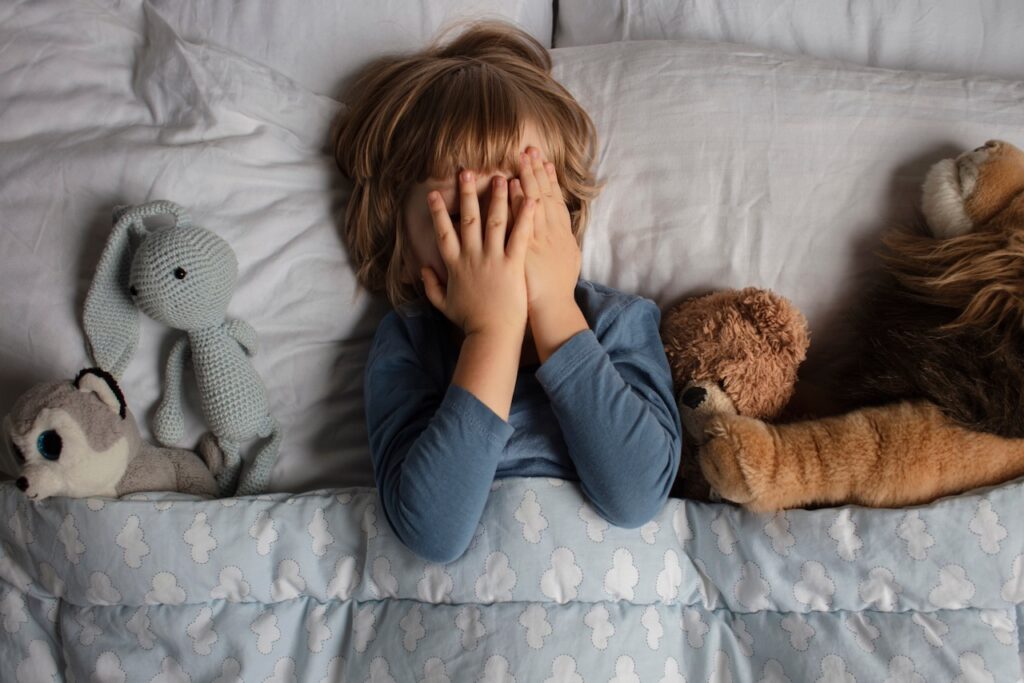
Anxiety is a feeling that occurs in various situations. Under certain circumstances, they accompany us throughout our lives. Sometimes feelings of fear are unfounded and cannot be explained rationally. But it is there! It shows itself. You can feel it. Fear is extremely versatile and manifests itself in completely different ways.
With an anxiety disorder, physical symptoms such as palpitations, weakness, and stomach problems occur in addition to psychological discomfort. Can you learn to cope with anxiety? The better option is to become active in order to get rid of excessive anxiety as soon as possible.
In order for your anxiety to become smaller and smaller, it is important to identify the reasons that led to your anxious behavior. With effective measures like Coaching you overcome even strong fears!

Help, I'm scared! Does this statement sound familiar? Everyone has fears. Actually, it is a normal reaction to danger. Fear arises in the brain when a situation is perceived as threatening.
In the official definition of fear, it is described as a basic feeling. It is supposed to help to recognize possible dangers at an early stage in order to protect oneself from them and to get to safety. But is this fear explanation sufficient to explain the symptoms? In any case, fear is crucial for survival. When you are afraid, your body mobilizes all its reserves to fight or flee.
What happens in the organism when you are afraid? First, a possible danger is perceived by your sensory organs. After the threat is detected, this perception is transmitted to the brain. Based on information already available in the Past The cerebral cortex interprets the danger situation based on the experience gained and classifies it accordingly.
The natural defense mechanism is activated by the amygdala in the brain sending a signal to the adrenal glands. More stress hormones such as cortisol and adrenaline are released. Your body gets ready for flight or fight.
While anxiety is useful and helpful in dangerous situations, pronounced feelings of anxiety can also indicate a mental illness. Why does anxiety have meaning for you? A distinction is made between general, rational (based on a real event) and diffuse anxiety.
Reality-based anxiety causes you to slam on the brakes in time to avoid an accident when driving. An anxiety disorder, on the other hand, can be recognized by the fact that the fears are irrational and excessively pronounced. Such fears, which include, for example, fear of flying, of insects, of confined or enclosed spaces, are called phobias.
Scientifically, a variety of fears are known. The various fears differ from each other in their causes, symptoms and severity. Most of the time, anxiety symptoms are easily manageable. Anxious feelings last only a short time. There are efficient measures that can help you minimize anxiety feelings. Professional support is often needed for anxiety disorders.
Fear arises seemingly out of nowhere. You are afraid without knowing why. Anxious feelings take away your breath. You feel dizzy. You feel weak.
The best way to find out where anxiety is really coming from is to do some root cause research. When did you first feel the anxiety? What did it feel like?
Common causes of anxiety are:
Too little emotional closeness, lack of Security or financial problems can promote the development of anxiety. Family events such as separation or divorce, as well as the death of a close relative, are often the triggers for feelings of anxiety.
Chronic physical or mental illnesses are associated with an increased risk of anxiety disorders. Anxiety is manifested by a wide variety of symptoms. Since these signs can also occur with other health problems, they are often not recognized as Anxiety disorder Symptoms detected.
Typical characteristics for anxiety are:
Severe anxiety can also cause symptoms such as:
trigger. Often, general anxiety is even associated with pain. However, for anxiety feelings to develop into an anxiety disorder, a number of factors must come together.

It is not known exactly how many types of fears exist. The Most important forms pathological anxiety are generalized anxiety disorder, panic disorder, obsessive-compulsive disorder as well as phobias and post-traumatic stress disorder.
Generalized anxiety disorder is characterized by the occurrence of severe anxiety in demonstrably non-threatening situations. Affected persons fear everyday situations and even things that are perceived by others as completely normal. Feelings of anxiety are experienced as very real.
In panic disorder, anxiety attacks occur suddenly. A trigger is not always identifiable. Basically, any "trigger" can lead to a Panic attack lead. People who suffer from panic disorder often avoid public places. They retreat to their homes because that is the only place where they feel safe. Usually panic attacks, which are perceived as extremely threatening, last only a few minutes.
If life is determined by the compulsion to control, this is predominantly an obsessive-compulsive disorder. Normal activities such as washing hands, cleaning or keeping order suddenly take on a completely different meaning. In a washing compulsion, hands are washed much more frequently than necessary. Although those affected themselves recognize the compulsive nature of their actions, they are unable to stop. Obsessive-compulsive disorder, formerly known as obsessive-compulsive disorder, is now considered the most common mental illness.
Phobias are excessive fears without a rational background. There are a variety of phobias. The best known are the Agoraphobia (fear of large places and crowds), dental phobia, social phobia (fear of interpersonal contact), aviophobia (fear of flying), arachnophobia (fear of spiders), and claustrophobia (fear of confined and enclosed spaces). In a phobia, the fears are limited to specific objects and situations. Due to the avoidance behavior, the quality of life can be significantly reduced in the case of a phobia.
Post-traumatic stress disorder (PTSD) is a mental illness. It usually occurs as a result of an unresolved, stressful event such as an accident, war or disaster. Incisive experiences such as rape, Domestic violence and other extreme situations can also trigger post-traumatic stress disorder. The horror is relived again and again in thoughts and dreams.
Anxiety can express itself in different ways. Anxieties can be strong or mild. Although feelings of anxiety have completely different causes, there are some typical fears. These include, for example xenophobia, known in the jargon as decidophobia. People who are afraid of changes in life often have difficulties, Making decisions.
The fear of the new and the unknown characterizes the Fear of the future, a form of anxiety in which uncertainty and fear of negative events are central.
Connectedness and familiarity is something beautiful. Yet many people are afraid of closeness. Commitment Anxiety usually arises in childhood. Those who have to learn in an early phase of life that love and trust cannot be taken for granted will later try to avoid attachments.
One of the most common fears is the Fear of failure. The fear of failure affects schoolchildren as much as students and top managers. If the fear of making mistakes is too great, a successful career is hardly possible. Fear of failure can severely limit both professional opportunities and private life.
Fear is part of life. In dangerous situations, it can prove to be a lifesaver. However, exaggerated fears are unsuitable to protect you from danger. Often, a realistic inventory is enough to transform feelings of fear. These five tips will help you to accept your fears:
Anxiety often leads to so-called avoidance behavior. Situations that can trigger or intensify feelings of fear are avoided. If you want to fight fear, this is not the solution!
Confront your fears by deliberately exposing yourself to a situation that could lead to a Anxiety could lead. In behavioral psychology, confrontation is described as an effective method for reducing anxiety. Are you afraid of speaking in front of people? Then first give a speech in a small circle, for example in front of friends or colleagues. This will give you more self-confidence.
Breathe deeply and feel inside yourself. You will quickly notice that the feelings of anxiety are getting smaller and smaller. Use a breathing technique to help you relax. Meditating helps to reach a state of inner peace and serenity. This way you can consciously Let go of fear. Try the meditation from our video right now.
Do some root cause research to better understand the background that led to your anxiety. Do you want to Get rid of fearsIf you want to avoid fear, you first need to know the reasons for your fearful behavior. To do this, open yourself up to a journey back in time to your childhood: How long has fear been with you? What was the decisive situation back then? Gretaor Coaching is an ideal way to get rid of your old blockages and fears. Beliefs and align yourself positively again.
Check your fears for their reality value. What really happens when you put yourself in a certain situation? Remember your successes. Positive experiences help to overcome fears.
Accept your fears. It is not a weakness to be afraid. Recognize that feelings of fear have a right to exist. The Acceptance of fears is a basic prerequisite for overcoming fears.
Anxiety arises from an interplay of physical and psychological factors. Anxiety is an emotional reaction (see video) transmitted by the sympathetic (autonomic) nervous system.
Depending on the cause or trigger, the brain initiates an activation pattern that leads to avoidance and escape behavior or to active defense. Depending on the level of anxiety, a variety of symptoms are triggered in the body.
Anxiety symptoms can range from a queasy Feeling or mild panic to violent waves of anxiety. The alarm reaction caused by the sympathetic nervous system has the following effects:
There are some differences between fear and anxiety. While anxiety has a useful warning function, irrational fears can interfere with life. For pathologically increased feelings of fear such as an anxiety disorder, phobias and obsessive-compulsive disorders, there are various behavioral psychological therapy approaches that have proven to be very effective.
With professional support, even long-standing fears can be resolved or at least minimized. Dealing with anxiety in the right way helps to reduce feelings of fear. The propensity to fear is shaped by our life experiences. Anxiousness is therefore completely normal. If you feel faster Worries If you do more than others, you may be particularly sensitive and react more sensitively.
Fear is a precautionary reaction of the body that is intended to protect us from danger. It is thus different from irrational fears and anxiety disorders, which can severely limit life. With simple measures, psychological procedures and professional support in the form of CoachingFears can be treated with this method. For this, you may first of all confront old beliefs and transform them into new, positive ones.
It is not about getting rid of the fear or fighting it: the first step is always to accept the fear! Everything that is there and regularly shows itself in us, goes along with a deeper message. Change your relationship to fear. Instead of controlling it and pushing it away, lovingly let it be there. Realize that fear is just a part of you and meet it head on. With every step you take towards it, it becomes smaller and smaller!

